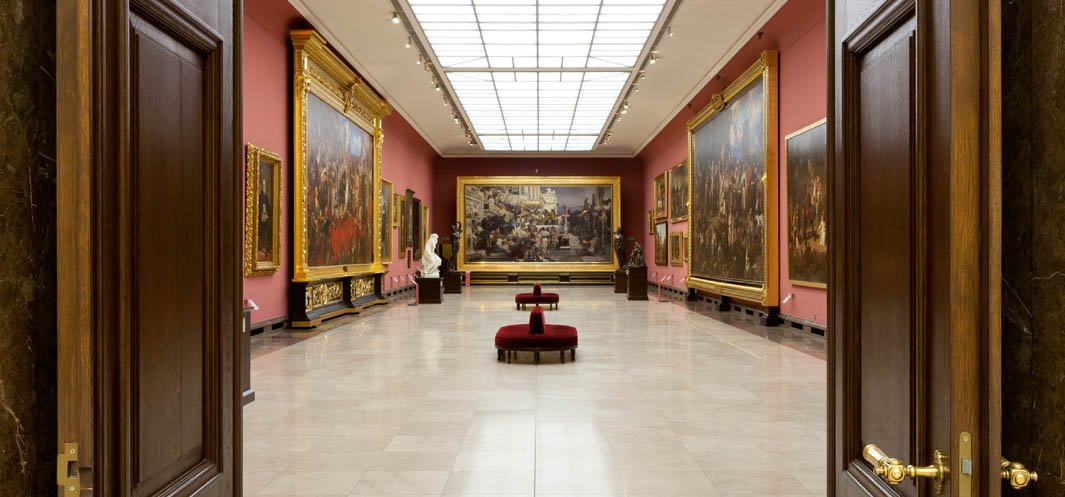The Gallery of 19th-Century Polish Art in the Sukiennice - The Siemiradzki Room
Around the Academy
Paintings and sculptures presented in this room were created in the circle of representative art, or art taught at academies of fine arts and displayed at official exhibitions, which usually appealed to the tastes and interests of the elites and the more affluent sections of society.
In the 19th century, European art was shaped by academies which instilled in students the principles of art work established as early as in the 17th century by the Royal Academy of Painting and Sculpture in Paris. According to these principles, art endows ideal beauty with real forms and illustrates the events taken from the Bible, mythology, literature and history, which are to be depicted in the painting as a tale or story. Hence in the academic hierarchy, history painting was regarded as the finest category, followed by less valued landscape, portrait and genre painting and finally – still life.
The development of archaeological and historical research resulted in the increase in knowledge of the realities of past epochs. History painters were required to depict past events as realistically as possible. One of the most important themes was the ancient era, as the fate of the persecuted Christians or Slavic gladiators bore resemblance to the situation of the oppressed Poles. A unique role in Polish history painting was played by Jan Matejko: his works were and still are admired by the whole society, as they satisfy the Poles' desire to see the glorious past of their nation.
An example of innovation in academic religious art is the painting by Feliks Cichocki-Nałęcz – "Our Lady the Spinner", which illustrates the desire to modernize and „humanize” the figure of the Virgin Mary, depicted in the course of her daily work.
Visits of Europeans to Africa and Asia aroused the interest of Polish artists in oriental themes, although they created rather uncomplicated genre scenes featuring exotic costumes and props. The Polish public was more likely to accept and appreciate genre themes if they were accompanied by patriotic references and associated with national tradition or history. Despite the invention of photography, painted portraits were still in demand and highly valued both by critics and visitors to the exhibitions and by customers.
In the 19th century, European art was shaped by academies which instilled in students the principles of art work established as early as in the 17th century by the Royal Academy of Painting and Sculpture in Paris. According to these principles, art endows ideal beauty with real forms and illustrates the events taken from the Bible, mythology, literature and history, which are to be depicted in the painting as a tale or story. Hence in the academic hierarchy, history painting was regarded as the finest category, followed by less valued landscape, portrait and genre painting and finally – still life.
The development of archaeological and historical research resulted in the increase in knowledge of the realities of past epochs. History painters were required to depict past events as realistically as possible. One of the most important themes was the ancient era, as the fate of the persecuted Christians or Slavic gladiators bore resemblance to the situation of the oppressed Poles. A unique role in Polish history painting was played by Jan Matejko: his works were and still are admired by the whole society, as they satisfy the Poles' desire to see the glorious past of their nation.
An example of innovation in academic religious art is the painting by Feliks Cichocki-Nałęcz – "Our Lady the Spinner", which illustrates the desire to modernize and „humanize” the figure of the Virgin Mary, depicted in the course of her daily work.
Visits of Europeans to Africa and Asia aroused the interest of Polish artists in oriental themes, although they created rather uncomplicated genre scenes featuring exotic costumes and props. The Polish public was more likely to accept and appreciate genre themes if they were accompanied by patriotic references and associated with national tradition or history. Despite the invention of photography, painted portraits were still in demand and highly valued both by critics and visitors to the exhibitions and by customers.
